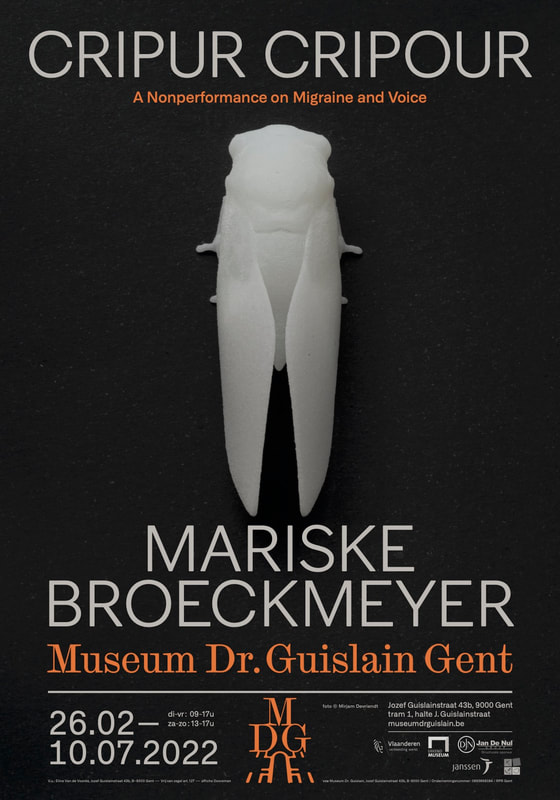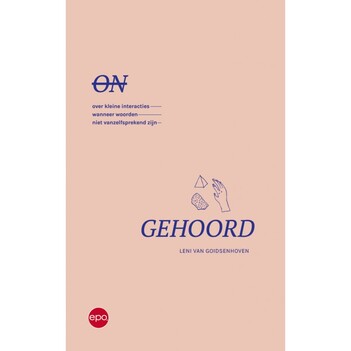PhD in the Arts
at LUCA School of Arts and KU Leuven
By Mariske Broeckmeyer
What can the voice reveal about the migraine experience and what can migraine teach us about what it means to be voiced? Shuttling between theoretical findings and artistic practice, I turn to concepts provided by voice theory, disability studies, psychoanalysis, queer theory and philosophy to create a framework that studies the relation between migraine and voice. By introducing artistic research in the spheres of voice theory, the voice is not merely tied to the paper but remains free to resonate. This way, I aim to provide a different and supplementary form of knowledge that reaches beyond traditional academic research methods. By focusing on the failing of the voice, I redefine the singer and her relation to the stage, while searching for an aesthetics of failure.
Supervisors:
Duration: 2017 - 2022
at LUCA School of Arts and KU Leuven
By Mariske Broeckmeyer
What can the voice reveal about the migraine experience and what can migraine teach us about what it means to be voiced? Shuttling between theoretical findings and artistic practice, I turn to concepts provided by voice theory, disability studies, psychoanalysis, queer theory and philosophy to create a framework that studies the relation between migraine and voice. By introducing artistic research in the spheres of voice theory, the voice is not merely tied to the paper but remains free to resonate. This way, I aim to provide a different and supplementary form of knowledge that reaches beyond traditional academic research methods. By focusing on the failing of the voice, I redefine the singer and her relation to the stage, while searching for an aesthetics of failure.
Supervisors:
- Dr. Jeroen D'hoe (supervisor, KU Leuven/LUCA)
- Dr. Anneleen Masschelein (co-supervisor, KU Leuven)
Duration: 2017 - 2022
Publications
Creating with 'Voice Without a Subject' - An Aesthetic Reconceptualization of Voice
In this methodological paper, co-written with Leni Van Goidsenhoven, we connect posthuman conceptualizations of voice with artistic research and examine whether it opens toward different registers and levels of embodied and aesthetic forms of knowing that cut across normative accounts of what it means to know. We argue that creating with ‘voice without subject’ makes tangible how personal experiences, however, temporarily, contribute to the bigger picture of how we look at and listen to people with illnesses and/or disabilities.
Dialectics of Outside and Inside -
A Sonic Study of Being through Illness and Isolation.
A Sonic Study of Being through Illness and Isolation.
This essay and audio piece explore how the related experiences of illness and isolation problematize the clear spatial opposition of “outside” and “inside.” Adopting the dialectical models, proposed by French philosopher Gaston Bachelard in his phenomenological study of outside and inside, I aspire to take aural notice on how the migraine sufferer’s sense of space shifts in sync with her sense of self throughout a migraine attack. Composed out of vocal sounds and domestic noises, recorded in and around the house, this piece merges the materiality of the room and voice in a conversation that balances on the edges of meaning. Juxtaposing one unto the other, both self and space get lost in displacement, matter melts and disappears into one roaring drone.
Contribution to Ongehoord,
a book composed by dr. Leni Van Goidsenhoven:
"De Migraine Parel - Of het Wangedrocht dat Zelfbescherming Heet"
March 2021
Impulsive Incatations - Voicing Migraine
When migraine arrives, not only the body suffers. The voice too is impacted by a condition that introduces itself with such great force. As a migraine-suffering singer I notice these changes and become fascinated by the aesthetics of a failing voice in a failing body. This exposition reflects upon the relevancy of Migraine Music as an aesthetic phenomenon and by focusing on the specific area of the vocal and the sonant, I project the issue into a broader context of language, speech and communication. First, I find the migraineur’s voice to be missing as it is silenced by society. Then, I study the failing of the voice when constricted by intense physical pain and I turn to the voice as it is transformed by migraine-specific symptoms. I study these deficiencies of the voice on a theoretical level in order to approach them through my artistic practice as a migraining singer. The artistic work accompanying this research is entitled Impulsive Incantations, and aims at voicing the migraine body through evocative text, vocal improvisations and a migrainous singing technique.
21 dec 2020 Journal For Artistic Research
------------------------------------------------------------------------
Presentatie als methode. Naar een geïntegreerde benadering van disseminatie in artistiek onderzoek.
The artistic researcher, just like his or her more traditional academic scientific colleagues, is often supposed to clarify his or her methodology. Both a linguistic and an artistic flexibility are required to be able to resonate with a diverse audience from different contexts. Yet methodological explanations usually result in abstract retrospective reflections that sometimes bear no relation to the actual work. Drawing on her own experience as a young researcher in the arts, Mariske Broeckmeyer makes a case for a natural integration of methodology into the artistic work – a goal that can only be achieved when the artist’s flexibility is used to its full potential and when the many and various moments of dissemination become the guiding principle, or even the essence, of the development of the research and the artistic practice.
21 Oct 2020 in Forum+
When migraine arrives, not only the body suffers. The voice too is impacted by a condition that introduces itself with such great force. As a migraine-suffering singer I notice these changes and become fascinated by the aesthetics of a failing voice in a failing body. This exposition reflects upon the relevancy of Migraine Music as an aesthetic phenomenon and by focusing on the specific area of the vocal and the sonant, I project the issue into a broader context of language, speech and communication. First, I find the migraineur’s voice to be missing as it is silenced by society. Then, I study the failing of the voice when constricted by intense physical pain and I turn to the voice as it is transformed by migraine-specific symptoms. I study these deficiencies of the voice on a theoretical level in order to approach them through my artistic practice as a migraining singer. The artistic work accompanying this research is entitled Impulsive Incantations, and aims at voicing the migraine body through evocative text, vocal improvisations and a migrainous singing technique.
21 dec 2020 Journal For Artistic Research
------------------------------------------------------------------------
Presentatie als methode. Naar een geïntegreerde benadering van disseminatie in artistiek onderzoek.
The artistic researcher, just like his or her more traditional academic scientific colleagues, is often supposed to clarify his or her methodology. Both a linguistic and an artistic flexibility are required to be able to resonate with a diverse audience from different contexts. Yet methodological explanations usually result in abstract retrospective reflections that sometimes bear no relation to the actual work. Drawing on her own experience as a young researcher in the arts, Mariske Broeckmeyer makes a case for a natural integration of methodology into the artistic work – a goal that can only be achieved when the artist’s flexibility is used to its full potential and when the many and various moments of dissemination become the guiding principle, or even the essence, of the development of the research and the artistic practice.
21 Oct 2020 in Forum+

